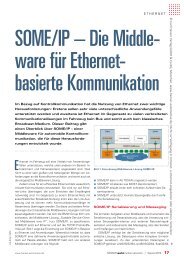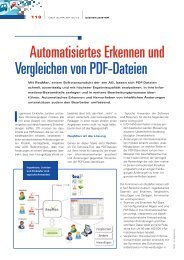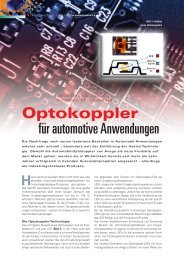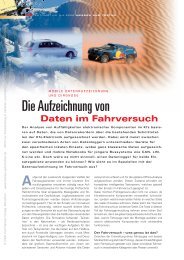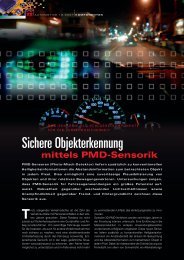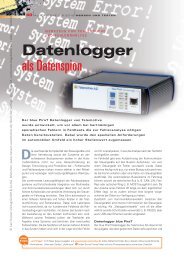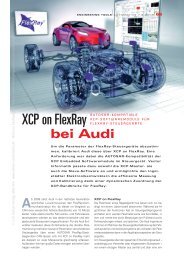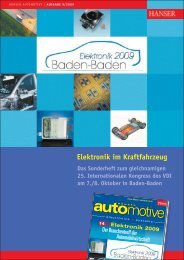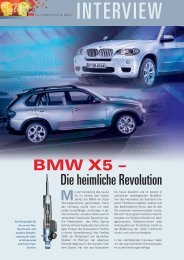Download - HANSER automotive
Download - HANSER automotive
Download - HANSER automotive
Create successful ePaper yourself
Turn your PDF publications into a flip-book with our unique Google optimized e-Paper software.
© Carl Hanser Verlag, München www.hanser-<strong>automotive</strong>.de Nicht zur Verfügung im Intranet- und Internet-Angeboten sowie elektronischen Verteilern<br />
14lA UTOMOTIVE 2007l 2008l SPECIAL EDITION FLEXRAY<br />
Fig. 2:Task synchronization for bypass scenarios via XCP on FlexRay.<br />
Fig. 3: Workflow for function bypassing via XCP on FlexRay<br />
configuration tool in the package allows users to assign the<br />
XCP master node and to select and configure the XCP slots<br />
of the FlexRay cycle necessary for bypassing, using the<br />
information in the ASAM MCD2 FBX (FIBEX) file. A Simulink<br />
library is generated according to the FlexRay configuration.<br />
After that, the bypass model can be implemented.<br />
The appropriate blocks from the RTI Bypass Blockset are<br />
used for selecting a suitable XCP slot and associating it<br />
with variables to be read from and written to the ECU. The<br />
set of variables available for selection is provided by the<br />
ECU description (ASAP2) file. In addition, the RTI Bypass<br />
Blockset provides configuration dialogs for creating further<br />
ECU variables that were not described in the ASAP2 file<br />
and that can be used for read and write access (Fig. 3).<br />
The synchronization of the ECU and the rapid prototyping<br />
system can be implemented with the help of the FlexRay<br />
Message Schedule or the RTI bypass interrupt mechanism.<br />
© <strong>automotive</strong><br />
If the interrupt mechanism is used, the<br />
calculation of the bypass model is triggered<br />
as soon as all the input values are<br />
available as specified in the model. If<br />
the FlexRay Message Schedule is used,<br />
the calculation of the bypass model is<br />
time-driven regardless of the input<br />
values that were received up to that<br />
point. The RTI Bypass Blockset offers<br />
various mechanisms to ensure data<br />
consistency<br />
Apart from function development<br />
making use of the external bypass<br />
approach, also various hardware-in-theloop<br />
(HIL) test scenarios require realtime<br />
access to ECUs. In these cases,<br />
the RTI Bypass Blockset can also be<br />
used on the HIL platforms: for example,<br />
for real-time tests or to capture the ECU<br />
data for real-time plausibility tests.<br />
© <strong>automotive</strong><br />
Measurement and Calibration via XCP<br />
on FlexRay<br />
Adapting the ECU software to engine and vehicle variants<br />
and validating the vehicle behavior are important milestones<br />
during the ECU development process. These specific<br />
applications are supported by CalDesk, the universal measurement,<br />
calibration and diagnostic tool from dSPACE. For<br />
communication with ECUs via XCP on FlexRay, CalDesk<br />
provides an XCP master implementation that allows users<br />
to measure ECU-internal variables and to adjust calibration<br />
parameters in the ECU software via FlexRay. CalDesk also<br />
lets users record and analyze measurement data from the<br />
vehicle bus, external measurement modules, further ECUs<br />
and dSPACE real-time systems. It is also possible to simultaneously<br />
adjust parameters on different platforms. In addition,<br />
typical diagnostic tasks such as reading and resetting<br />
the ECU’s fault memory via dedicated instruments are sup-



